
A bogie is a chassis or framework that carries a wheelset, attached to a vehicle—a modular subassembly of wheels and axles. Bogies take various forms in various modes of transport. A bogie may remain normally attached or be quickly detachable. It may include a suspension component within it, or be solid and in turn be suspended ; it may be mounted on a swivel, as traditionally on a railway carriage or locomotive, additionally jointed and sprung, or held in place by other means.

EM gauge is a variant of 4 mm to a foot (1:76) scale used in model railways.

In both road and rail vehicles, the wheelbase is the horizontal distance between the centers of the front and rear wheels. For road vehicles with more than two axles, the wheelbase is the distance between the steering (front) axle and the centerpoint of the driving axle group. In the case of a tri-axle truck, the wheelbase would be the distance between the steering axle and a point midway between the two rear axles.
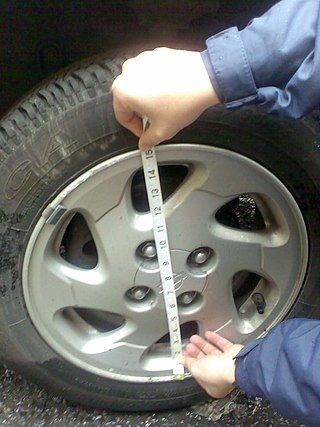
The wheel size for a motor vehicle or similar wheel has a number of parameters.
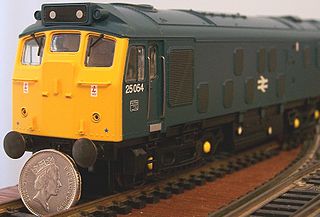
4 mm scale is the most popular model railway scale used in the United Kingdom. The term refers to the use of 4 millimeters on the model equating to a distance of 1 foot (305 mm) on the prototype (1:76.2). It is also used for military modelling.
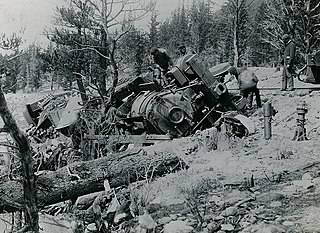
In rail transport, a derailment is a type of train wreck that occurs when a rail vehicle such as a train comes off its rails. Although many derailments are minor, all result in temporary disruption of the proper operation of the railway system and they are a potentially serious hazard.

An adhesion railway relies on adhesion traction to move the train, and is the most widespread and common type of railway in the world. Adhesion traction is the friction between the drive wheels and the steel rail. Since the vast majority of railways are adhesion railways, the term adhesion railway is used only when it is necessary to distinguish adhesion railways from railways moved by other means, such as by a stationary engine pulling on a cable attached to the cars or by a pinion meshing with a rack.
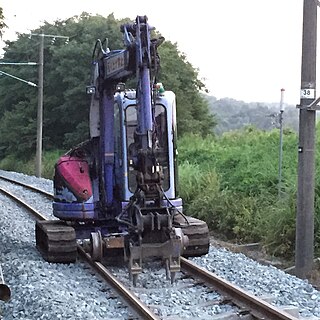
A road–rail vehicle or a rail–road vehicle is a dual-mode vehicle which can operate both on rail tracks and roads. They are also known as two-way vehicles, hi-rail, and rail and road vehicles.

A rut is a depression or groove worn into a road or path by the travel of wheels or skis. Ruts can be formed by wear, as from studded snow tires common in cold climate areas, or they can form through the deformation of the asphalt concrete, pavement or subbase material. In modern roads the main cause is heavily loaded trucks. These heavy loaded trucks imprint their tire impressions on roads over time, causing ruts. Rut is a common pavement distress and is often used in pavement performance modeling.

A variable gauge system allows railway vehicles in a train to travel across a break of gauge between two railway networks with different track gauges. For through operation, a train must be equipped with special bogies holding variable gauge wheelsets which contain a variable gauge axle (VGA).
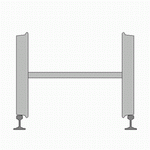
Hunting oscillation is a self-oscillation, usually unwanted, about an equilibrium. The expression came into use in the 19th century and describes how a system "hunts" for equilibrium. The expression is used to describe phenomena in such diverse fields as electronics, aviation, biology, and railway engineering.
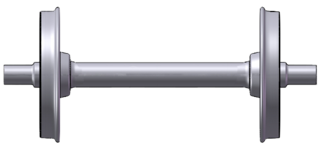
A wheelset is a pair of railroad vehicle wheels mounted rigidly on an axle such that both wheels rotate in unison. Wheelsets are often mounted in a bogie – a pivoted frame assembly holding at least two wheelsets – at each end of the vehicle. Most modern freight cars and passenger cars have bogies each with two wheelsets, but three wheelsets are used in bogies of freight cars that carry heavy loads, and three-wheelset bogies are under some passenger cars. Four-wheeled goods wagons that were once near-universal in Europe and Great Britain and their colonies have only two wheelsets; in recent decades such vehicles have become less common as trainloads have become heavier.

Gauge conversion is the changing of one railway track gauge to another.

In railway engineering, curve resistance is a part of train resistance, namely the additional rolling resistance a train must overcome when travelling on a curved section of track. Curve resistance is typically measured in per mille, with the correct physical unit being Newton per kilo-Newton (N/kN). Older texts still use the wrong unit of kilogram-force per tonne (kgf/t).

The Beugniot lever (Beugniot-Hebel) is a mechanical device used on a number of locomotives to improve curve running. It was named after its inventor Édouard Beugniot.
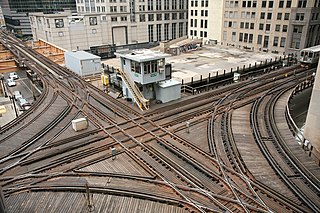
The minimum railway curve radius is the shortest allowable design radius for the centerline of railway tracks under a particular set of conditions. It has an important bearing on construction costs and operating costs and, in combination with superelevation in the case of train tracks, determines the maximum safe speed of a curve. The minimum radius of a curve is one parameter in the design of railway vehicles as well as trams; monorails and automated guideways are also subject to a minimum radius.
SUW 2000 is a Polish variable gauge system that allows trains to cross a break of gauge. It is interoperable with the German Rafil Type V system.
A railway or railroad is a track where the vehicle travels over two parallel steel bars, called rails. The rails support and guide the wheels of the vehicles, which are traditionally either trains or trams. Modern light rail is a relatively new innovation which combines aspects of those two modes of transport. However fundamental differences in the track and wheel design are important, especially where trams or light railways and trains have to share a section of track, as sometimes happens in congested areas.

A train wheel or rail wheel is a type of wheel specially designed for use on railway tracks. The wheel acts as a rolling component, typically press fitted onto an axle and mounted directly on a railway carriage or locomotive, or indirectly on a bogie, also called a truck. The powered wheels under the locomotive are called driving wheels. Wheels are initially cast or forged and then heat-treated to have a specific hardness. New wheels are machined using a lathe to a standardized shape, called a profile, before being installed onto an axle. All wheel profiles are regularly checked to ensure proper interaction between the wheel and the rail. Incorrectly profiled wheels and worn wheels can increase rolling resistance, reduce energy efficiency and may even cause a derailment. The International Union of Railways has defined a standard wheel diameter of 920 mm (36 in), although smaller sizes are used in some rapid transit railway systems and on ro-ro carriages.

















